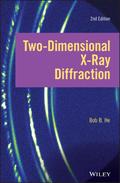Two-dimensional X-ray Diffraction

2. Auflage August 2018
496 Seiten, Hardcover
Praktikerbuch
Die zweidimensionale Röntgendiffraktion ist die ideale, zerstörungsfreie Analysemethode für Proben aller Art. Hierzu gehören Metalle, Polymere, Keramiken, Halbleiter, Dünnfilme, Beschichtungen, Farben, Biomaterialien, Verbundstoffe u.v.m. Die 2. Auflage von Two-Dimensional X-Ray Diffraction erläutert als aktuelles Referenzwerk, wie die neuesten 2D-Dektektoren in Diffraktometer integriert werden, wie sich mithilfe eines 2D-Detektors für Diffraktometer die besten Daten gewinnen lassen und wie die Daten zu interpretieren sind. Überaus hilfreich für alle, die die 2D-Diffraktion im eigenen Labor umsetzen möchten, sind die Ausführungen des Autors zu den physikalischen Prinzipien, zur Projektionsgeometrie und zu mathematischen Ableitungen.
- Bietet neue Inhalte in allen Kapiteln. Die meisten Abbildungen sind gänzlich in Farbe und zeigen so mehr Einzelheiten in den Illustrationen und Diffraktionsmustern.
- Deckt die jüngsten Fortschritte in der Detektortechnik und bei Strategien zur zweidimensionalen Datensammlung ab, die dazu geführt haben, dass 2D-Detektoren verstärkt in der Röntgendiffraktion zum Einsatz kommen.
- Behandelt ausführlich neue Innovationen im Hinblick auf Röntgenquellen, Optik, Systemkonfigurationen, Anwendungen und Algorithmen zur Datenevaluierung.
- Enthält neue Methoden und Beispiele für Versuchsaufbauten für Belastungs-, Textur-, Kristallgröße-, Kristallorientierungs- und Dünnfilmanalysen.
Die 2. Auflage von Two-Dimensional X-Ray Diffraction ist ein wichtiges Referenzwerk für Forscher und Entwickler in den Materialwissenschaften, der Chemie und Physik sowie im Pharmabereich, sowohl in der Industrie als auch im universitären Umfeld, und für alle, die die Röntgendiffraktion als Charakterisierungsverfahren einsetzen. Dieses Nachschlagewerk darf in der Handbibliothek von Anwendern auf allen Ebenen, von Gerätetechnikern, Managern in Röntgenlabors und Geräteentwicklern nicht fehlen.
1. Introduction 1
1.1 X-Ray Technology, a Brief History, 1
1.2 Geometry of Crystals, 2
1.3 Principles of X-Ray Diffraction, 11
1.4 Reciprocal Space and Diffraction, 13
1.5 Two-Dimensional X-Ray Diffraction, 19
References, 26
2. Geometry and Fundamentals 29
2.1 Introduction, 29
2.2 Diffraction Space and Laboratory Coordinates, 31
2.3 Detector Space and Detector Geometry, 35
2.4 Sample Space and Goniometer Geometry, 46
2.5 Transformation from Diffraction Space to Sample Space, 50
2.6 Reciprocal Space, 52
2.7 Summary, 53
References, 55
3. X-Ray Source and Optics 57
3.2 X-Ray Optics, 63
References, 85
4. X-Ray Detectors 87
4.1 History of X-Ray Detection Technology, 87
4.2 Point Detectors in Conventional Diffractometers, 89
4.3 Characteristics of Point Detectors, 92
4.4 Line Detectors, 100
4.5 Characteristics of Area Detectors, 107
4.6 Types of Area Detectors, 119
References, 137
5. Goniometer and Sample Stages 141
5.1 Goniometer and Sample Position, 141
5.2 Goniometer Accuracy, 145
5.3 Sample Alignment and Visualization Systems, 149
5.4 Environment Stages, 151
References, 155
6. Data Treatment 157
6.1 Introduction, 157
6.2 Non-Uniform Response Correction, 157
6.3 Spatial Correction, 161
6.4 Detector Position Accuracy and Calibration, 166
6.5 Frame Integration, 177
6.6 Multiple Frame Merge, 186
6.7 Scanning 2D Pattern, 194
6.8 Lorentz, Polarization, and Absorption Corrections, 197
References, 208
7. Phase Identification 211
7.1 Introduction, 211
7.2 Relative Intensity, 212
7.3 Geometry and Resolution, 216
7.4 Sampling Statistics, 221
7.5 Preferred Orientation Effect, 227
References, 233
8. Texture Analysis 235
8.1 Introduction, 235
8.2 Pole Density and Pole-Figure, 236
8.3 Fundamental Equations, 238
8.4 Data Collection Strategy, 242
8.5 Texture Data Process, 251
8.6 Orientation Distribution Function, 256
8.7 Fiber Texture, 261
8.8 Polymer Texture, 264
8.9 Other Advantages of XRD2 for Texture, 268
References, 269
9. Stress Measurement 271
9.1 Introduction, 271
9.2 Principle of X-ray Stress Analysis, 280
9.3 Theory of Stress Analysis with XRD2, 292
9.4 Process of Stress Measurement with XRD2, 307
9.5 Experimental Examples, 325
A9.1 Calculate Principal Stresses, 349
A9.2 Calculate the direction cosines for principal stresses (Eigenvectors), 350
References, 353
10. Small Angle X-ray Scattering 357
10.1 Introduction, 357
10.2 2D SAXS Systems, 361
10.3 Applications Examples, 367
10.4 Some Innovations in 2D SAXS, 370
References, 374
11. Combinatorial Screening 379
11.1 Introduction, 379
11.2 XRD2 Systems for High Throughput Screening, 380
11.3 Combined Screening with XRD2 and Raman, 390
Reference, 393
12. Miscellaneous Applications 395
12.1 Percent Crystallinity, 395
12.2 Crystal Size, 402
12.3 Retained Austenite, 412
12.4 Crystal Orientation, 414
12.5 Thin Film Analysis, 418
Reference, 429
13. Innovation and Future Development 433
13.1 Introduction, 433
13.2 Scanning Line Detector for XRD2, 434
13.3 Three-Dimensional Detector, 438
13.4 Pixel Direct Diffraction Analysis, 441
13.5 High Resolution Two-Dimensional X-Ray Diffractometer, 444
References, 451
Appendix A. Values of Commonly Used Parameters 453
Appendix B. Symbols 459
Index 465


